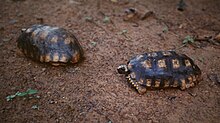Brazilian giant tortoise
| Yellow-footed tortoise | |
|---|---|
 |
|
| Chelonoidis denticulata | |
| Scientific classification | |
| Kingdom: | Animalia |
| Phylum: | Chordata |
| Class: | Reptilia |
| Order: | Testudines |
| Suborder: | Cryptodira |
| Family: | Testudinidae |
| Genus: | Chelonoidis |
| Species: | C. denticulata |
| Binomial name | |
|
Chelonoidis denticulata (Linnaeus, 1766) |
|
| Synonyms | |
|
|
The yellow-footed tortoise (Chelonoidis denticulata), also known as the Brazilian giant tortoise, is a species of tortoise in the family Testudinidae and is closely related to the red-footed tortoise (C. carbonaria). It is found in the Amazon Basin of South America.
With an average length of 40 cm (15.75 in) and the largest known specimen at 94 cm (37 in), this is the sixth-largest tortoise species on Earth, after the Galapagos tortoise, the Aldabra tortoise, the African spurred tortoise (Geochelone sulcata, typical size 76 cm (30 in)), the leopard tortoise (Stigmochelys pardalis), and the Asian forest tortoise (Manouria emys emys, typical size 60 cm (23.6 in)).
The yellow-footed tortoise is also called the yellow-foot or yellow-legged tortoise, the Brazilian giant tortoise, or South American forest tortoise, as well as local names such as morrocoy, woyamou or wayamo, or some variation of jabuta. Many of the local names are shared with the similar red-footed tortoise.
Originally, Karl Linnaeus assigned all turtles and tortoises to the genus Testudo and identified this species as Testudo denticulata in 1766 with testudo meaning turtle, and denticulata meaning "tooth-like", referring to the jagged or serrated edges of the shell. Soon the term Testudo was only being used for tortoises as opposed to all chelonians, with tortoises defined by completely terrestrial behaviors, heavy shells, and elephant-like limbs with nails but no visible toes. The species got several other names, as well, for several reasons such as difficulty in distinguishing it from the red-footed, confusion over locations, researchers thinking they had discovered a new species in collections or in the field, etc.
Leopold Fitzinger created the genus Geochelone, meaning "earth turtle" for medium-to-large tortoises that did not come from the Mediterranean area (which remained Testudo), or have other special characteristics such as the hinged shells of the Kinixys genus. Fitzinger further used the term Chelonoidis as a subgenus to categorize Geochelone from South America. Neither term was widely used until they were resurrected by researchers such as Williams in 1960.
...
Wikipedia

